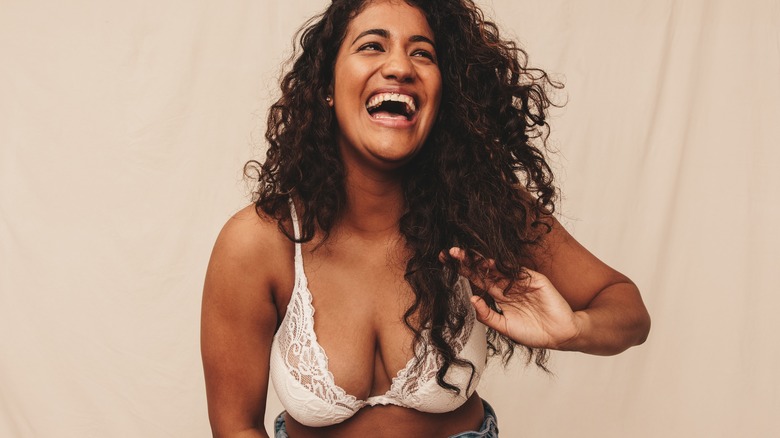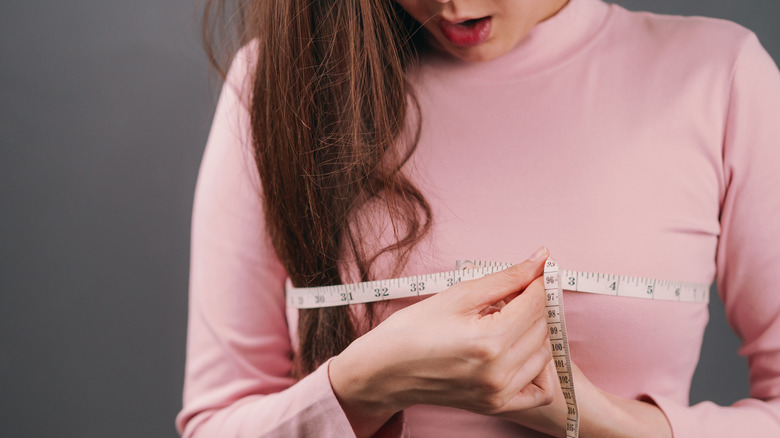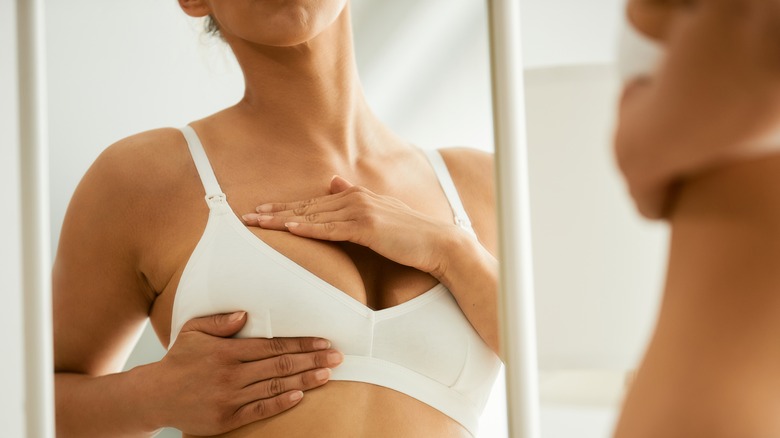How Wearing A Too-Tight Bra Can Be Hazardous To Your Health
There is nothing quite like that feeling of relief when you unhook your bra at the end of a long day. The freedom and comfort are overwhelming but often short-lived since most women spend the majority of their waking hours wearing a bra. Interestingly, research suggests that people rely on bras to improve their body image as they age.
Breasts dropping or sagging is natural and simply a part of growing older. However, buying bras specifically for aesthetics or to improve confidence levels might be why so many women wear the incorrect bra size for their bodies. Of course, others might be buying the wrong size unknowingly, which is why relying entirely on a measurement you received in a hectic store isn't always the best idea. Instead, learning the best way to measure your bra size at home is key.
With so many hours of your day spent in a bra, it's imperative that it is sized correctly and benefits your body. While the pros and cons of wearing bras have been debated for years, they are designed to provide support, improve posture, and prevent back pain. Of course, these benefits are synonymous with correct sizing. There are various styles of bras from strapless to sports bras to underwire and wireless. Finding the right one for you will depend on your breast size and body type.
The risks of incorrect sizing
There are a variety of health risks associated with consistently wearing bras that are too tight for your body. Many of these involve the surrounding skin. Because a bra that is too tight won't provide the intended support, it can lead to pain, skin stretching, and scratches on the surface of the skin. As the Montclair Breast Center points out, tight bras can also potentially cut off blood circulation, leading to more serious cardiovascular issues.
If you frequently notice red marks where your wired bra lays under your breasts, it's likely far too tight around your chest. Bras can also leave permanent indentations between your neck and shoulders because of the weight bearing down on the straps in that area.
Since wearing a bra that doesn't fit correctly will inevitably lead to neck, back, or shoulder pain, it leaves many hesitant to work out, which reduces overall health and wellness. Of course, those with larger, heavier breasts will likely experience these risks to a greater degree. On top of these health concerns, a 2003 study shared in the British Journal of Plastic Surgery found a direct link between women seeking breast reduction surgery and those wearing an incorrect bra size.
The five steps to take when searching for the perfect fit
While certain bra types are best for smaller chests, the thought of going braless and boycotting the entire concept has become extremely appealing. Unfortunately, it's not the best choice for those who feel like they need that support. Plus, it isn't the only option. Having go-to bras that fit correctly and feel great is not only possible but a necessity.
Often, young women get measured in a store, given their bra size, and go with it. When women reach their full cup size, many never look back or revisit their final sizing. However, bra sizes are notoriously hard to measure because women's bodies are all so different. Measurements are frequently taken on top of clothes while wearing current bras that likely don't fit well either. It may seem like the cycle is never-ending but luckily, nobody knows your body better than you.
Therefore, the solution lies in empowering women to know how their bras should be fitting, despite changes in breast shape and size. As The University of Portsmouth breaks down in a helpful video, there are five main categories to consider when trying on a bra: On your bra, you want your underband to be level, the front to be flat, your straps to be comfortable, the cups to be form-fitting, and the underwire to naturally outline your breasts. Once you put these tips into practice, finding the right fit will start feeling like second nature.


